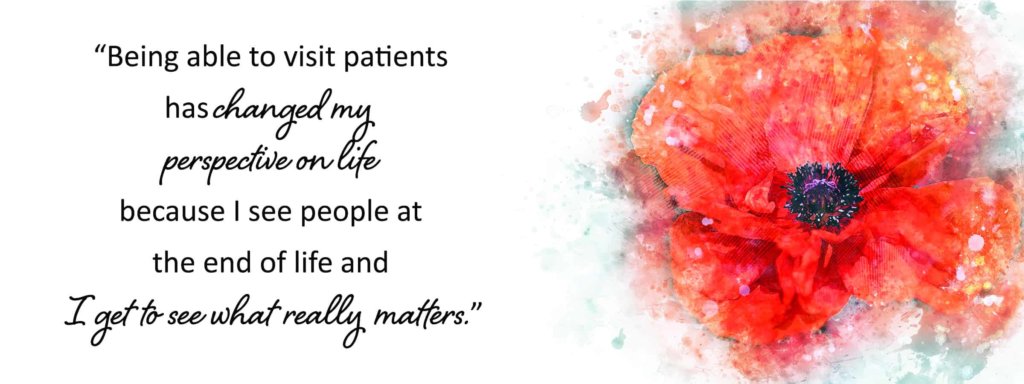
Hospice is:
Hospice care is a specialized type of care that aims to focus on the quality of life for individuals who experience a life-limiting terminal illness of six months or less. The goal of hospice is to allow comfort during the last phase of the incurable disease to let the patient live as comforable as the disease process allows (Hospice Foundation of America). Hospice care can be provided in; long-term care facilities, an acute medical facility, homes, or an inpatient hospice facility. Hospice will provide the following to patient’s and families; spiritual care, family meetings, coordination of care, and bereavement services.
Hospice Philosophy:
“Hospice philosophy accepts death as the final stage of life – It affirms life, but does not hasten or postpone death. A hospice team will treat the person and symptoms of the disease, rather than treating the disease itself. The interdisciplinary team of professionals work together to manage symptoms that way a person’s last days may be spent with dignity and quality, surrounded by their loved ones” (American Cancer Society).

As your loved one gets sicker:
As the disease progresses, loved ones will endorse, increased weakness, assistance, and symptom management. As this process continues, hospice is able to keep your loved one in their comfort environment with adding supplies, medications, DME, and emotional support as requested by the family or patient (Mayo Foundation 2021).
- Nursing staff will increase their visits to 7x/week.
- Social workers will be available to the family and patient for support.
- Chaplains will be available to the family and patient for life review and emotional support.
- Certified nursing assistants will increase their visits to 7x/week to aid patients with personal hygiene.
If a crisis occurs:
Going through this end-of-life journey without life having different plans can a challange and can have conflicts with the hospice plan of care. The hope is that having a hospice care team available 24/7 allows patients to get effective help quickly without needing to escalate the type of care they are receiving (Phongtankuel, 2019). If the patient decides to pursue going to the hospital this is allowed just ensure hospice is notified as this is considered a change in status, hospice does have the ability to promote comfort over the phone with the use of medications in the home; Morphine, Lorazepam or Atropine. Hospice is able to provide urgent nursing visits and the ability to do an urgent medication delivery if the patient needs it through their own pharmacy.
How to know death is near:
A patient who is actively dying will experience a series of things;
- Decreased level of conciousness
- Bed-bound
- Non-verbal cues of pain/discomfort
- Changes in the rate and depth of breathing
- Decreased ability to eat and drink
At this point in the EOL process, medication dosages, frequency, and route of administration will be monitored by the hospice team and make changes as necessary to keep the patient comfortable.
After the final breath was taken:
Once death has occurred, hospice will be notified either by the family or another healthcare professional caring for the patient. The hospice nurse will come out to do the death pronouncement and will call to notify the funeral home. Patient’s can remain in the home until the family is ready to release the body. Hospice’s bereavement team will remain available for family support. Bereavement services are available to family members for 13 months following the death (Cake & Lambert, 2022).

References:
Cake, & Amanda Lambert, M. S. (2022, June 2). What happens when someone dies at home with hospice? Cake Blog. Retrieved August 31, 2022, from https://www.joincake.com/blog/what-happens-when-someone-dies-at-home-with-hospice/
Mayo Foundation for Medical Education and Research. (2021, March 2). Hospice care: Comforting the terminally ill. Mayo Clinic. Retrieved August 31, 2022, from https://www.mayoclinic.org/healthy-lifestyle/end-of-life/in-depth/hospice-care/art-20048050
Phongtankuel, V., Burchett, C. O., Shalev, A., Adelman, R. D., Prigerson, H. G., Czaja, S. J., Dignam, R., Baughn, R., & Reid, M. C. (2019). Perceptions of a Home Hospice Crisis: An Exploratory Study of Family Caregivers. Journal of palliative medicine, 22(9), 1046–1051. https://doi.org/10.1089/jpm.2018.0511
What is Hospice? Hospice Foundation of America. (n.d.). Retrieved August 31, 2022, from https://hospicefoundation.org/Hospice-Care/Hospice-Services

Hello,
I really enjoyed reading your blog post about hospice care! Prior to reading your post, I did not have a clear understanding of hospice care and often confused it with palliative care. You provided a great explanation of your topic in a way that made it easy for anyone to understand. I had no idea that hospice care can be provided in so many different settings. I appreciate how you included information on what happens after death. I feel as though this is something that is not frequently talked about and I’m glad that I now have a better understanding of this. I also can appreciate the in-text citations and reference list that you included; this helped me as a reader feel as though the information provided was accurate and trustworthy. In addition to content, I also admire the design and layout that you chose for your blog post. The shorter paragraphs and titled sections helped to keep me interested in reading more. I also really liked how you incorporated bulleted lists. Overall, your blog post was very informative and the layout was well thought out.